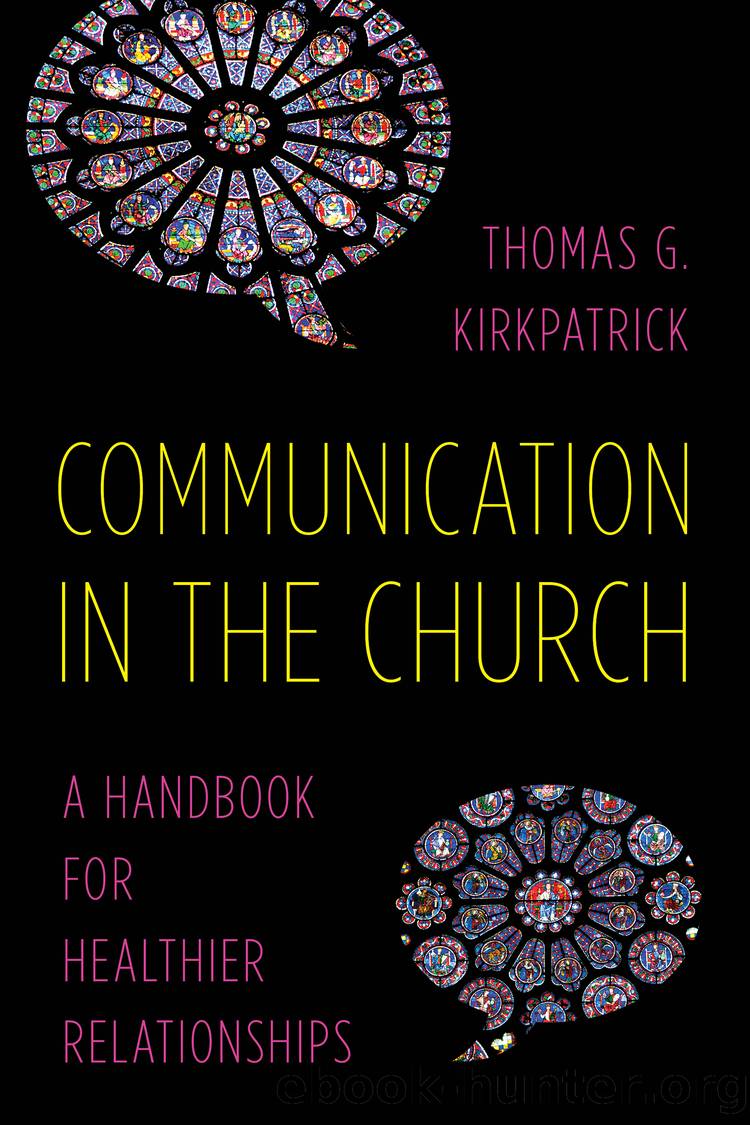Communication in the Church by Kirkpatrick Thomas G.;

Author:Kirkpatrick, Thomas G.; [Krikpatrick, Thomas G.]
Language: eng
Format: epub
Publisher: Rowman & Littlefield Publishers, Incorporated
Published: 2016-08-15T00:00:00+00:00
Unfortunately, little research has been done on how people who are related to one another practice forgiveness and reconciliation. We do know families vary in how they process and practice forgiveness and reconciliation. Some families are comfortable with direct communication about wrongdoing and explicit granting of forgiveness while others find less direct ways of communicating and expressing forgiveness. We also know that families with a good record of forgiving and reconciling with one another are more cohesive, stable, and committed to one another. Members of such families also have greater emotional and physical well-being and healthier levels of family functioning. Finally, much of what we have already learned about the processes and practices of forgiveness and reconciliation is applicable among family membersââthough turmoil over wrongdoing may mean these processes are much more complicated and these practices much more challenging than between couples or individuals.19
When we think of people who are related to one another, we often think of relatives or extended family members such as parents, grandparents, siblings, spouses, partners, children, and in-laws. But there also are people related to us in our congregational families such as our pastors, lay leaders, members, and mission partners. Both types of families experience turmoil, hurtful behavior, careless communication, broken trust, and fractured relationshipsââand the need to experience forgiveness, healing from hurt, careful communication, reconciliation, repair of broken relationships, and a restoration of relational health.
The experience of Frankie and Dannie gave us a look at the processes and practices of forgiveness and reconciliation among roommates, spouses, or domestic partners. Let us now examine a typical example of turmoil among people in a congregational family, including wrongdoing and these same processes and practices.
Congregational Turmoil Scenario
A one-hundred-member congregation is situated on five acres in an increasingly low-income, multicultural neighborhood. The congregation is eager to reach out to its neighborhood. Longtime members still hope for a return to the glory days of the 1950s and â60s when it was a five-hundred-member congregation.
As the outreach ministry team considers how best to use all the congregationâs resources to serve people in need, it wonders if there might be a better use for a sizable portion of their land than as a place for neighbors to walk their dogs. They are mindful of increasing complaints by the building-and-grounds people about how long it takes to mow a field used only once or twice during the year for an ice-cream social or rummage sale. Outreach team members are excited about developing this largely unused portion of its land for much-needed low-income housing in the congregationâs community.
Council members are receptive to this ministry opportunity, but immediately run into resistance from a small number of longtime members who feel their dream of congregational expansion slipping away. After holding several informal congregational meetings to brief members on land sale options and to respond to member fears and concerns, the congregationâs leaders present a land sale recommendation to the congregation and ask for a vote of approval. Opposition from disgruntled members mounts as the vote draws near.
Download
This site does not store any files on its server. We only index and link to content provided by other sites. Please contact the content providers to delete copyright contents if any and email us, we'll remove relevant links or contents immediately.
Signature in the Cell: DNA and the Evidence for Intelligent Design by Stephen C. Meyer(2879)
Real Sex by Lauren F. Winner(2867)
The Holy Spirit by Billy Graham(2777)
The Secret Power of Speaking God's Word by Joyce Meyer(2753)
The Gnostic Gospels by Pagels Elaine(2399)
Jesus by Paul Johnson(2227)
Devil, The by Almond Philip C(2205)
23:27 by H. L. Roberts(2144)
The Nativity by Geza Vermes(2115)
Chosen by God by R. C. Sproul(2055)
All Things New by John Eldredge(2052)
Angels of God: The Bible, the Church and the Heavenly Hosts by Mike Aquilina(1868)
Angels by Billy Graham(1843)
The Return of the Gods by Erich von Daniken(1840)
Knowing God by J.I. Packer(1724)
Jesus of Nazareth by Joseph Ratzinger(1708)
Evidence of the Afterlife by Jeffrey Long(1704)
The Gnostic Gospel of St. Thomas by Tau Malachi(1679)
How To Be Born Again by Billy Graham(1670)
